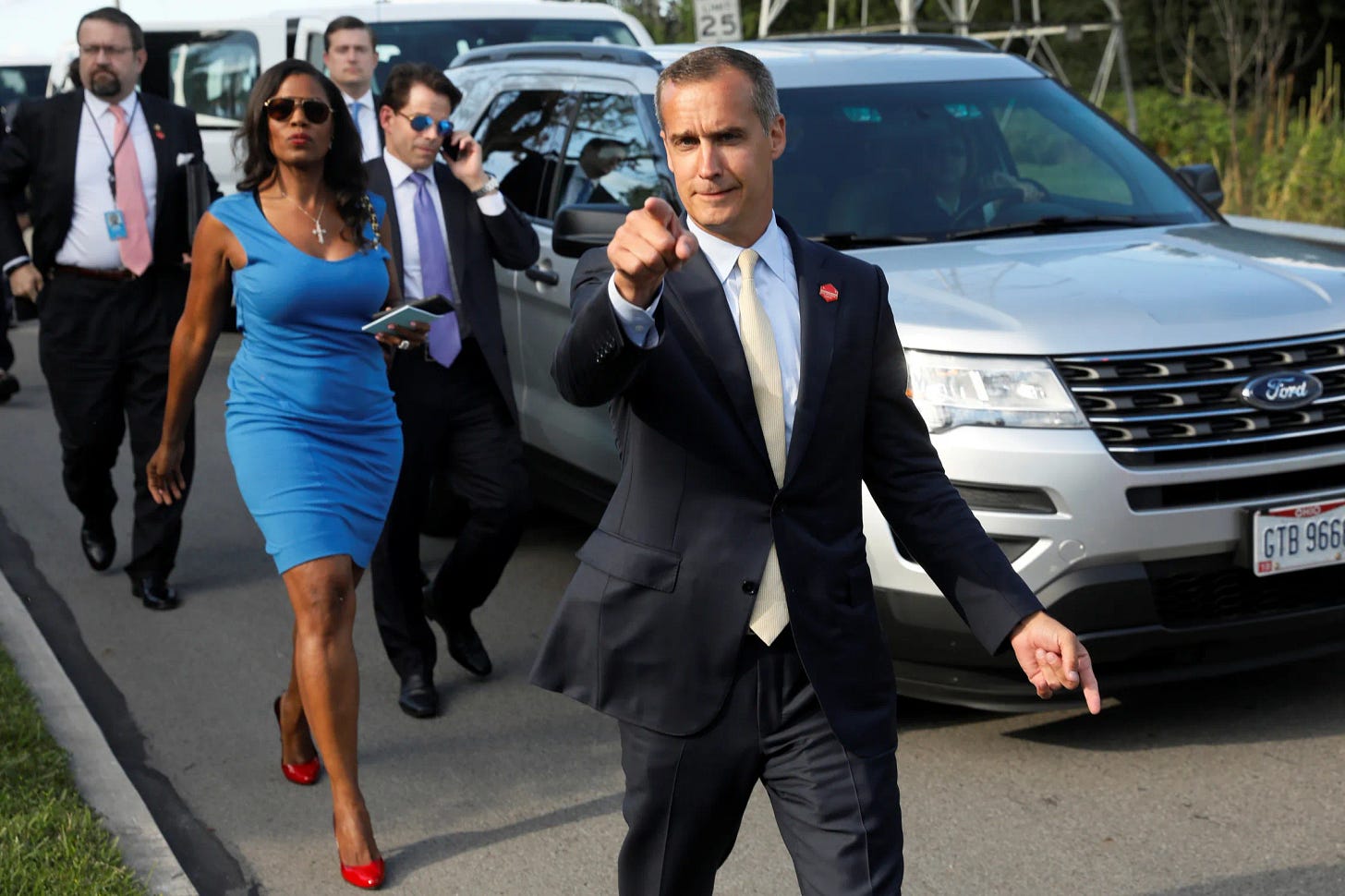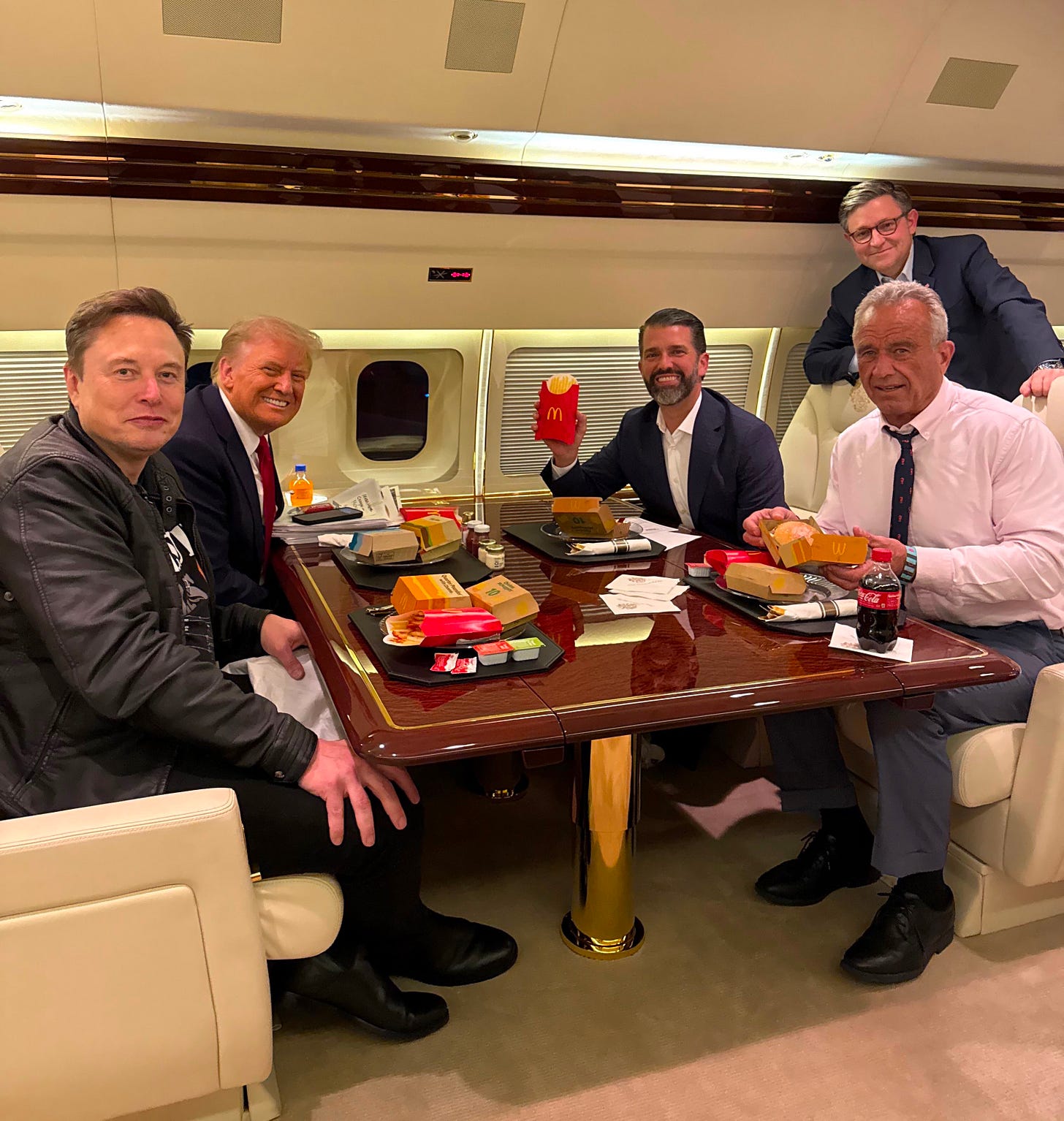I don’t see a credit, probably Don Jr. handed his phone to someone else who snapped the shot on Trump Force One last week. Junior then put the photo on Twitter.
I just love it. An appropriate caption would be “The Devil’s Breakfast.” The most powerful elected official, the richest man, two troubled scions from two troubled dynasties, and even an unwelcome photobomb from comparative nobody Mike Johnson. (They could stop the Speaker of the House from sitting down at their table, but they could not stop him from joining the photo!)
Their unhappy smiles loom over fast food that is almost certainly not going to be eaten.
Truly, a perfect image.
There was a perfect photo last time as well, taken by Jonathan Ernst for Reuters. This one could be captioned “Pride Before the Fall,” because almost everyone was fired.

From the blizzard of post-election think pieces, three I liked, from a jazz cat and two favorite political commentators who specialize in realism:
Sam Newsome, “Substance Over Symbolism: An Honest Look at What Went Wrong.”
If we conclude this election simply proves “America is sexist and racist,” we miss the deeper lesson. These issues matter, but they don’t explain everything. This election suggests a need to move beyond identity politics and address people’s day-to-day concerns. In challenging times, the pressing demands of everyday life—paying bills, securing jobs—can overshadow broader social issues.
Freddie DeBoer, “Don’t Panic.”
The hard times never end, but because they never end, they aren’t really hard times, they’re just times.
Ross Barkan, “The Outer Borough Mind: Understanding Donald Trump.”
In the Democratic Party, Trump sees Manhattan. His followers see Manhattan, too. They exult because they have won, but they lack all patrician grace, or the self-assuredness a technocratic, managerial party might bring to bear in victory. They are ruddy and angry and anxious. They know, when their thoughts go quiet and the TV’s turned down low, this is it—this is the zenith. Second term presidents get unpopular. Majorities slip away. Opponents wise up.
Read Barkan’s mesmerizing piece, and then look at the photo “The Devil’s Breakfast” again. It’s all there.
There is one possible upside to this catastrophe, which would be the end of Trump-related social justice art. It feels played out. They didn’t care; they re-elected him anyway. And was resistance art really a good idea to begin with?
Two more recent screeds I admire:
Dean Kissick, “The Painted Protest: How Politics Destroyed Contemporary Art.” (Cover article in Harper’s Magazine)
We lie to one another and to ourselves that all this humdrum work is inspiring, that it has an influence on how opinions are formed and hearts are won, but, of course, it doesn’t. Nobody cares, which is partly why the exhibitions feel so lifeless.
Kat Rosenfield, “Can We Please Have Less Political Art Now?”
It’s not just that the art produced under the banner of resistance failed to achieve its singular objective (though if anything, eight years of excruciatingly on-the-nose storytelling seems to have irritated audiences so much that they are now in full revolt, flocking to any film, no matter how idiotic, that promises entertainment over partisan signaling). It’s that when you can’t imagine a higher creative purpose than keeping one loathsome politician out of the White House — or a lifespan for your work that extends past the next presidential election — the result inevitably falls short of greatness, or even goodness. The most memorable thing about the art shaped by this paradigm is how forgettable it all is, how small and predictable and shrill and soulless.
The only thing sadder than having spent eight years like this would be to submit to it for even a single moment more. To allow Donald Trump to live rent-free in our heads like some sort of perverse anti-muse. To narrow our songs, our stories, until the barbaric yawp of the artist becomes nothing more than a reactionary squawk of indignation.



